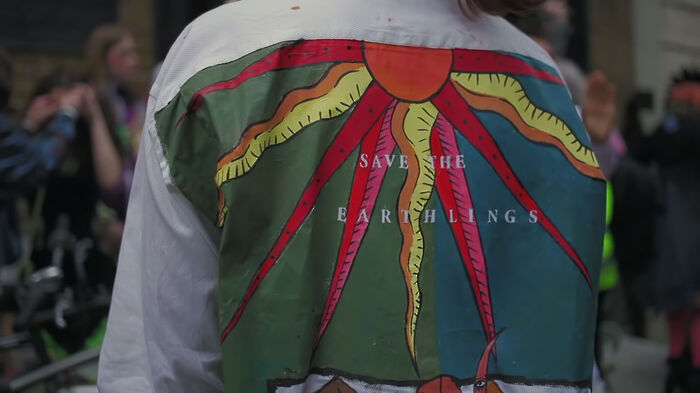In a hopeless time, Gucci sets the standard for eco couture
As environmental activists turn their attentions from fast fashion to couture, they demand real change, and no company typifies the commitment required quite like Gucci.

Is it possible, reasonable, or in any way feasible, for luxury fashion brands to exist against the backdrop of an increasingly desperate climate crisis? As Extinction Rebellion calls for an end to London Fashion Week, more and more people are asking themselves what it means for these high end brands to continue to thrive when their existence relies on constant consumption. Fast fashion may be killing the planet with every kilo of sweat-shop t-shirts produced, but equally the jet-setting world of luxury brands like Prada and Gucci has never seemed more redundant. When fashion supposedly lacks even the mentally uplifting aspects of high art, why do we allow designers and fashion houses to continue to ship materials and models around the world, experimenting and creating outfits that will never see the light of day after their ten minutes of limelight on a catwalk?
Even the big players in fashion have begun to recognise the apparent pointlessness of their industry in a world running out of time. Marco Bizzarri, CEO of Gucci, has acknowledged that “The best way to have zero emissions is to close the company.” A shockingly self-aware statement for the fashion industry in any context, Bizzarri is however even more convincing when he details exactly why he has no intention of following through on such a plan. Luxury fashion in and of itself may appear to serve little purpose in our modern world, but the 18,000 people Gucci alone employs, as well as the countless traditional industries and creative techniques it helps keep alive, may well disagree. “At the end of the day our company makes things, and we employ thousands of people with families and communities to do that. We need to think up the best ways of supporting our employees to do their jobs in the most sustainable way possible.” Concern for the environment does not necessarily preclude caring for the people living in it.
Ecological concern is, painfully slowly, becoming almost trendy. As old men on Twitter rage against Greta Thunberg, fashion brands geared towards “the youth” are finally realising the power of caring, or at least being seen to care. However, while Gucci are certainly not unaware of the power of good publicity on ecological matters for sales, their commitment shows more than a simple awareness of trends and profit lines. In 2007, they were able to confirm that all of their jewellery was ethically mined. They were also one of the first companies to ban the use of fur, starting in its 2018 collection. Now they are truly leading the way: following on from a carbon neutral runway, Bizzarri has announced his intention to make the entire company carbon neutral by the end of this month.
And when Gucci says carbon neutral, they mean it. Not only did they include the carbon footprint of their guests’ travel plans in their calculations for offsetting the cost of the Milan runway, but their new initiative to achieve carbon neutrality will also be including their entire supply chain, which contributes 90% of Gucci’s overall greenhouse gas emissions. Many other brands discount this aspect when discussing their own attempts at reducing their emissions; not only does it obviously make those perfect targets far harder to reach, but it often does not come under direct management, and thus is seen as far harder to change. Gucci historically has not let itself be limited by such impotent concerns. When they decided they were going to look into the sources of their jewellery, they didn’t rely on the mining companies or the auditing of third parties, but instead got involved in the whole process directly.
Gucci’s products remain far out of the reach of the average student budget and the outfits that appear on the catwalk are unlikely to turn up in their full extravagance in highstreet shops anytime soon. However, that doesn’t mean that these advances are meaningless. As Bizzarri said in his statement, what matters is not that Gucci has done it first, or done it best, but rather that Gucci has done it at all, and, hopefully, these pushes (and the good publicity which follows) will inspire many other fashion brands, luxury or otherwise, to emulate their achievements.
 News / News in Brief: SU says sayonara to sabbs (again) and Cunk comes to Cambridge5 January 2025
News / News in Brief: SU says sayonara to sabbs (again) and Cunk comes to Cambridge5 January 2025 Lifestyle / Blind Date: ‘He gave me a good strategy for stealing from formals’5 January 2025
Lifestyle / Blind Date: ‘He gave me a good strategy for stealing from formals’5 January 2025 Features / Does Cambridge have a caffeine problem?4 January 2025
Features / Does Cambridge have a caffeine problem?4 January 2025 Fashion / The decline of Depop and the rise of Vinted5 January 2025
Fashion / The decline of Depop and the rise of Vinted5 January 2025 Science / Stay cold to treat a cold?5 January 2025
Science / Stay cold to treat a cold?5 January 2025





